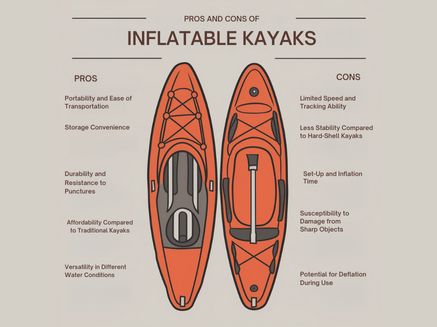
Tessa Young
Kayak Expert

John Smith
![]() Expert Reviewed |Kayak Expert
Expert Reviewed |Kayak Expert
[timeanddate]
Inflatable kayaks offer unmatched portability and convenience, but understanding the pros and cons of inflatable kayaks is crucial before purchasing.
Inflatable kayaks have gained popularity among paddlers for their portability, ease of storage, and affordability. Whether you’re a beginner or an experienced kayaker, understanding the pros and cons of inflatable kayaks is essential for making an informed decision. This guide will explore the advantages and disadvantages of inflatable kayaks, helping you decide if they’re the right choice for your next adventure.

On This Page
What Is An Inflatable Kayak And How Does It Work?
An inflatable kayak is a lightweight, portable watercraft made from durable materials such as PVC or Hypalon. Designed for easy transport and storage, these kayaks can be inflated using a hand or electric pump, transforming from a compact package into a robust, buoyant vessel.
Multiple air chambers ensure that the kayak remains afloat even if one section is compromised. Once fully inflated, it provides a stable platform for paddling on various water bodies, including lakes, rivers, and coastal waters.
Pros of Inflatable Kayaks
1. Portability and Ease of Transportation
Inflatable kayaks are renowned for their portability. When deflated, they fold down to a manageable size, often fitting into a carry bag. This makes them perfect for adventurers who travel frequently or those with limited storage space.
Whether you’re heading to a remote river or a tranquil lake, an inflatable kayak can easily be transported in the trunk of a car, on public transportation, or even as luggage on a plane.
2. Storage Convenience
Unlike traditional kayaks, inflatable models do not require a dedicated storage space. Once deflated, they can be stowed in a closet, under a bed, or in the corner of a garage. This convenience is particularly beneficial for urban dwellers or anyone with limited storage options at home.
3. Durability and Resistance to Punctures
Modern inflatable kayaks are made from highly durable materials that resist punctures and abrasions. Reinforced with robust layers of PVC or Hypalon, these kayaks can withstand encounters with rocks, branches, and other potential hazards. Multiple air chambers add an extra layer of safety, ensuring the kayak remains buoyant even if one chamber is punctured.
4. Affordability Compared to Traditional Kayaks
Inflatable kayaks tend to be more affordable than their hard-shell counterparts. This makes them an attractive option for beginners or recreational paddlers who want to experience kayaking without a substantial financial investment. Despite the lower cost, many inflatable kayaks offer impressive performance and durability.
5. Versatility in Different Water Conditions
Inflatable kayaks are incredibly versatile, performing well in various water conditions. Whether you plan to paddle on calm lakes, navigate gentle rivers, or explore coastal areas, there is an inflatable kayak designed to meet your needs. Some models are even built to handle mild whitewater, adding to their versatility.
Cons of Inflatable Kayaks
1. Limited Speed and Tracking Ability
One of the primary drawbacks of inflatable kayaks is their limited speed and tracking ability compared to hard-shell models. Their softer structure and lighter weight can make it challenging to maintain a straight course, especially in windy conditions or strong currents.
2. Less Stability Compared to Hard-Shell Kayaks
While many inflatable kayaks are stable, they generally offer less stability than hard-shell kayaks, particularly in rough waters. This can be a concern for novice paddlers or those who prefer more challenging kayaking environments.
3. Set-Up and Inflation Time
Inflatable kayaks require time to set up and inflate before use. Depending on the model and the pump used, this can take anywhere from 5 to 20 minutes. For paddlers who prefer to get on the water quickly, this setup time may be seen as an inconvenience.
4. Susceptibility to Damage from Sharp Objects
Despite their durability, inflatable kayaks are still vulnerable to damage from sharp objects like rocks, branches, or debris in the water. Paddlers need to exercise caution and avoid areas with potential hazards that could puncture or damage the kayak.
5. Potential for Deflation During Use
Although rare with high-quality models, there is a potential risk of deflation during use. A puncture or valve malfunction can cause an air leak, which may require immediate repair or re-inflation. Carrying a repair kit is essential for addressing any issues that may arise on the water.
Tips for Choosing an Inflatable Kayak
1. Consider Intended Use and Water Conditions
Determine where and how you plan to use the kayak. Different models are designed for specific conditions, such as calm lakes, whitewater rapids, or coastal waters. Choose a kayak that matches your intended use to ensure optimal performance and safety.
2. Look for Quality Materials and Construction
Invest in a kayak made from high-quality materials such as reinforced PVC or Hypalon. Check for robust seams, multiple air chambers, and reliable valves. Quality construction will ensure durability, longevity, and safety.
3. Check Weight Capacity and Seating Options
Consider the weight capacity of the kayak to ensure it can accommodate you and any additional gear you plan to bring. Also, evaluate the seating options for comfort, especially if you plan on extended trips. Some models offer adjustable seats and extra padding for added comfort.
4. Read Reviews and Seek Recommendations
Research and read reviews from other kayakers to get insights into the performance, durability, and comfort of different models. Seeking recommendations from experienced paddlers can also help you make an informed decision.
5. Consider Additional Accessories and Features
Look for kayaks that come with useful accessories such as paddles, pumps, repair kits, and carry bags. Additional features like storage compartments, footrests, and fishing rod holders can enhance your kayaking experience and provide extra convenience.
Final Thoughts
Inflatable kayaks offer a practical and versatile option for paddlers of all levels. They combine the benefits of portability, ease of storage, and affordability with the joy of kayaking. By carefully considering your needs and preferences, you can choose an inflatable kayak that provides the perfect balance of performance, durability, and convenience, ensuring many enjoyable adventures on the water.
FAQS:
Are inflatable kayaks safe to use?
Yes, inflatable kayaks are safe when used properly. They are made from durable materials and have multiple air chambers, which add to their safety. Always follow manufacturer guidelines and wear a life jacket for added protection.
Are inflatable kayaks harder to paddle?
Inflatable kayaks are generally easy to paddle, though they may be slightly slower than rigid kayaks due to their design. With practice, most paddlers find them stable and maneuverable, especially in calm waters.
Is it worth buying an inflatable kayak?
An inflatable kayak is worth buying if you need a portable, easy-to-store option. They are affordable, versatile, and perfect for casual paddling on lakes, rivers, or calm coastal waters.
Are inflatable kayaks durable enough for regular use?
Yes, modern inflatable kayaks are durable and designed for regular use. They are made from tough materials like PVC or Hypalon, which can withstand punctures and abrasions when used in appropriate conditions.
About Author

Tessa Young
Kayak Expert
Tessa Young is a highly experienced kayak expert with over 8 years of dedicated work in the kayaking industry. Her in-depth knowledge and passion for water sports make her a reliable source of information for kayakers of all levels. Tessa has extensively tested and reviewed a wide range of kayaks, offering expert advice to help readers make informed decisions. Her insights are valued by those looking for trustworthy recommendations on the best kayaks for various needs and environments.
Read More

John Smith
Expert Reviewed | Kayaks Expert
John Smith is an accomplished kayak reviewer with more than 12 years of expertise in evaluating kayak performance and quality. His thorough and unbiased reviews have made him a respected figure among kayaking enthusiasts. John’s extensive experience on the water enables him to provide detailed assessments, focusing on key aspects such as stability, speed, and durability. Readers can rely on John’s expert evaluations to guide them in choosing the right kayak for their adventures.
Read More




